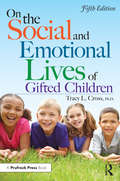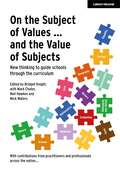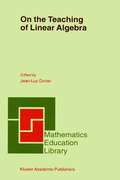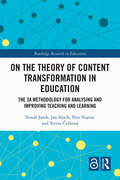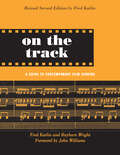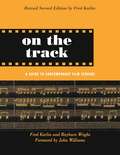- Table View
- List View
On the Social and Emotional Lives of Gifted Children
by Tracy L. CrossRaising happy, successful children is a goal of every parent of gifted children. In On the Social and Emotional Lives of Gifted Children, the nation's leading authority on the psychology of gifted children offers advice and encouragement for both parents and teachers. In a thoughtful, conversational style, the author offers an in-depth look at the complex social and emotional issues faced by gifted children. This revised and updated fifth edition of the popular text contains more than 12 new chapters.On the Social and Emotional Lives of Gifted Children tackles important and timely issues dealing with the social and emotional needs of today's gifted children, including who gifted children are and what giftedness means; how parents, teachers, and counselors can guide gifted children; the issues facing gifted students in the 21st century, such as technology and terrorism; and how the education of gifted children can adapt for the future. This concise, sensitive look at gifted children and their social and emotional world offers unique insights for both teachers and parents who support these special children.
On the Social and Emotional Lives of Gifted Children
by Tracy L. CrossRaising happy, successful children is a goal of every parent of gifted children. In On the Social and Emotional Lives of Gifted Children, the nation's leading authority on the psychology of gifted children offers advice and encouragement for both parents and teachers. In a thoughtful, conversational style, the author offers an in-depth look at the complex social and emotional issues faced by gifted children. This revised and updated fifth edition of the popular text contains more than 12 new chapters.On the Social and Emotional Lives of Gifted Children tackles important and timely issues dealing with the social and emotional needs of today's gifted children, including who gifted children are and what giftedness means; how parents, teachers, and counselors can guide gifted children; the issues facing gifted students in the 21st century, such as technology and terrorism; and how the education of gifted children can adapt for the future. This concise, sensitive look at gifted children and their social and emotional world offers unique insights for both teachers and parents who support these special children.
On the Subject of Drama
by David HornbrookAlthough much has been written on how the drama elements of the English curriculum might be taught in schools, there is less guidance available for teachers who regard drama not as an adjunct of English but as an arts subject in its own right. In this volume, David Hornbrook and a team of experienced drama specialists show how the subject of drama may be defined and taught. Drawing on literature, visual art, music and dance as well as the rich and varied traditions of drama itself, they map out an eclectic subject curriculum for students of all ages. Opening up the field in new and exciting ways, the book embraces the widest possible range of dramatic knowledge and skills, from the Natyashastra of ancient India to contemporary classroom improvisation. The book is divided into three sections: The teaching and learning of drama: ideas about interculturalism, creativity and craft - key concepts informing the drama curriculum - are interrogated and re-theorised for the classroom. Making and performing drama in school: the fundamental processes of reading and writing plays for performance are explored, along with the potential of dance to enhance and extend students' experience of dramatic performance. Watching and understanding drama: ensuring the curriculum is appropriately balanced between the production and reception of drama, this last section emphasises the role of students as audience - for both live and electronic performances - and the development of a dramatic vocabulary.
On the Subject of Drama
by David HornbrookAlthough much has been written on how the drama elements of the English curriculum might be taught in schools, there is less guidance available for teachers who regard drama not as an adjunct of English but as an arts subject in its own right. In this volume, David Hornbrook and a team of experienced drama specialists show how the subject of drama may be defined and taught. Drawing on literature, visual art, music and dance as well as the rich and varied traditions of drama itself, they map out an eclectic subject curriculum for students of all ages. Opening up the field in new and exciting ways, the book embraces the widest possible range of dramatic knowledge and skills, from the Natyashastra of ancient India to contemporary classroom improvisation. The book is divided into three sections: The teaching and learning of drama: ideas about interculturalism, creativity and craft - key concepts informing the drama curriculum - are interrogated and re-theorised for the classroom. Making and performing drama in school: the fundamental processes of reading and writing plays for performance are explored, along with the potential of dance to enhance and extend students' experience of dramatic performance. Watching and understanding drama: ensuring the curriculum is appropriately balanced between the production and reception of drama, this last section emphasises the role of students as audience - for both live and electronic performances - and the development of a dramatic vocabulary.
On the Subject of Values ... and the Value of Subjects: New thinking to guide schools through the curriculum
Education is a values-based experience. Consciously or not, we are highly attuned to one another's values. We see, time and again, that the 'best' schools are compelled and propelled by strong values which inspire and guide the creation of a meaningful context for learning and an aspirational ethos.However, values can often be submerged, overlooked, or ignored. By infusing our teaching with values, both explicit and implicit, learning can serve a greater purpose, nourishing us as humans and deepening our experience.Drawing on the views and inspired teaching practice of a range of contributors, this book offers both the theoretical underpinning and practical examples to bring values to life in the classroom. It shows how each subject has a unique and valuable role, and how a values-based culture generates a powerful climate for successful learning in every subject discipline.It is a 'bedside book' that will bring joy and practical support to the many professionals who work from the heart and wish to touch the future. It offers validation to those teachers who deeply care about the subject disciplines they teach, ultimately making a difference to children, their lives, and their world.In our current educational context, this work is unashamedly people-orientated, futures-thinking, and forward-facing.
On the Supreme Court: Without Illusion and Idolatry
by Louis Fisher"On the Supreme Court" places the Supreme Court in a rich historical and political context, demonstrating how its interpretations of statutes and the Constitution are necessarily shared with the elected branches, the 50 states, and the general public. It explains why the Court exercises judicial review, not judicial supremacy. It demonstrates that, contrary to popular opinion, the Court does not supply the final or exclusive word on the Constitution. In an era of tectonic changes, "On the Supreme Court" offers a fresh perspective on this mainstay institution from a scholar with unique insights as a Constitutional specialist as well as a Congressional researcher.Key features of the text: "
On the Supreme Court: Without Illusion and Idolatry
by Louis Fisher"On the Supreme Court" places the Supreme Court in a rich historical and political context, demonstrating how its interpretations of statutes and the Constitution are necessarily shared with the elected branches, the 50 states, and the general public. It explains why the Court exercises judicial review, not judicial supremacy. It demonstrates that, contrary to popular opinion, the Court does not supply the final or exclusive word on the Constitution. In an era of tectonic changes, "On the Supreme Court" offers a fresh perspective on this mainstay institution from a scholar with unique insights as a Constitutional specialist as well as a Congressional researcher.Key features of the text: "
On the Teaching of Linear Algebra (Mathematics Education Library #23)
by Jean-Luc DorierThis book presents the state-of-the-art research on the teaching and learning of linear algebra in the first year of university, in an international perspective. It provides university teachers in charge of linear algebra courses with a wide range of information from works including theoretical and experimental issues.
On the Teaching of Literature: From Charismatic Secrecy to Joyful Revelation
by Flemming OlsenDrawing on the author's teaching practice and experience, this book is based on the premise that reading and analysing literary texts are rewarding pursuits. The target group is grammar school pupils and students at colleges of education and universities. Pedagogic theories are dealt with only in so far as they are applicable to the teaching situation. After establishing the distinction between fiction, which demands a willing suspension of disbelief, and non-fiction, which is set in the universe of the pupils experience, succeeding chapters set out the benefits for the teaching of literature -- namely, how it encompasses psychology, history, and aesthetics. It fulfils the Horatian demand profit and delight. After addressing the pedagogic assets and liabilities of various theories of the concept of text, what lies at the heart of the book is how teachers tackle their role in guiding and inspiring without pontificating. The invitation to the student is to co-operate constructively, but not uncritically. Issues of interpretation and the passing on of interpretative paradigms are alerted to, which leads naturally on to the pedagogic challenge of explaining the potentialities of different genres, and the necessity of a firm grounding in technical terms like composition, style, theme, metaphor, etc. as didactic tools. A concluding chapter suggests criteria that may make value and evaluation rest on strong foundations in acknowledgement of the subjective elements inherent in the literary experience, namely to avoid making literary analysis a schematic formula and to ensure that it promotes the expansion of the students humanistic horizon. This book is essential reading for all those involved in teaching Literature and Language.
On the Theory of Content Transformation in Education: The 3A Methodology for Analysing and Improving Teaching and Learning (Routledge Research in Education)
by Tomáš Janík Jan Slavík Petr Najvar Tereza ČeškováThis volume presents a novel, theoretical, micro-analytical model – the 3A Methodology – for assessing the quality of school education.Drawing on philosophers as well as theoretical and pedagogical traditions from European and American contexts, the authors construct a model that is relevant to teachers, researchers, and teacher educators regardless of cultural setting. The chapters explain the 3A Methodology as a specific research tool developed to study classroom situations in the form of case studies, revealing findings that demonstrate prototypical failures (didactic formalism) that threaten to compromise the quality of learning as well as prototypical didactic virtues that verifiably support students’ learning. Ultimately building on the distinction of three modes of existence of educational content (the intersubjective, the subjective, and the objective modes), the book helps rediscover didactics as a transdisciplinary theory of content transformation and contributes to the improvement of teaching and learning in the classroom long term.This volume will be of interest to scholars, researchers, and postgraduate students working in school education, educational psychology, and didactics more broadly. Teacher educators and school administrators may also find the book of interest.Chapters 1, 3, and 6 of this book is freely available as a downloadable Open Access PDF at http://www.taylorfrancis.com under a Creative Commons Attribution-Non Commercial-No Derivatives (CC-BY-NC-ND) 4.0 license.
On the Theory of Content Transformation in Education: The 3A Methodology for Analysing and Improving Teaching and Learning (Routledge Research in Education)
by Tomáš Janík Jan Slavík Petr Najvar Tereza ČeškováThis volume presents a novel, theoretical, micro-analytical model – the 3A Methodology – for assessing the quality of school education.Drawing on philosophers as well as theoretical and pedagogical traditions from European and American contexts, the authors construct a model that is relevant to teachers, researchers, and teacher educators regardless of cultural setting. The chapters explain the 3A Methodology as a specific research tool developed to study classroom situations in the form of case studies, revealing findings that demonstrate prototypical failures (didactic formalism) that threaten to compromise the quality of learning as well as prototypical didactic virtues that verifiably support students’ learning. Ultimately building on the distinction of three modes of existence of educational content (the intersubjective, the subjective, and the objective modes), the book helps rediscover didactics as a transdisciplinary theory of content transformation and contributes to the improvement of teaching and learning in the classroom long term.This volume will be of interest to scholars, researchers, and postgraduate students working in school education, educational psychology, and didactics more broadly. Teacher educators and school administrators may also find the book of interest.Chapters 1, 3, and 6 of this book is freely available as a downloadable Open Access PDF at http://www.taylorfrancis.com under a Creative Commons Attribution-Non Commercial-No Derivatives (CC-BY-NC-ND) 4.0 license.
On the Track: A Guide to Contemporary Film Scoring
by Fred Karlin Rayburn WrightOn the Track offers a comprehensive guide to scoring for film and television. Covering all styles and genres, the authors, both noted film composers, cover everything from the nuts-and-bolts of timing, cuing, and recording through balancing the composer's aesthetic vision with the needs of the film itself. Unlike other books that are aimed at the person "dreaming" of a career, this is truly a guide that can be used by everyone from students to technically sophisticated professionals. It contains over 100 interviews with noted composers, illustrating the many technical points made through the text.
On the Track: A Guide to Contemporary Film Scoring
by Fred Karlin Rayburn WrightOn the Track offers a comprehensive guide to scoring for film and television. Covering all styles and genres, the authors, both noted film composers, cover everything from the nuts-and-bolts of timing, cuing, and recording through balancing the composer's aesthetic vision with the needs of the film itself. Unlike other books that are aimed at the person "dreaming" of a career, this is truly a guide that can be used by everyone from students to technically sophisticated professionals. It contains over 100 interviews with noted composers, illustrating the many technical points made through the text.
On the Waves of a Pulsating World: An Engineer’s Adventures in Innovation, Education and Politics: From Russia to the West (Springer Biographies)
by Vladimir BabitskyVladimir Babitsky was born before the Second World War and migrated West after Perestroika. The theory of vibro-impact systems that he developed helped create the world’s safest jackhammer and other record-breaking machines. The author has lived through a series of fascinating epochs: experiencing life under totalitarianism, witnessing the Soviet Union’s collapse, and then migrating to Europe as a specialist in his field. “On the Waves of a Pulsating World” is an animated and highly engaging story about the journey of an engineer; from childhood daydreams to creating new technologies, from East to West, and from concepts to realities. It is also the story of people who outshine authoritarianism.
On the Way to Canon: Creative Tradition History in the Old Testament (The Library of Hebrew Bible/Old Testament Studies)
by Magne SæbøIn this collection of essays-many of them here published in English for the first time-the distinguished Norwegian Old Testament scholar, Magne S3/4b°, investigates the complex and variegated history of traditions constituting the literature of the Old Testament. Professor S3/4b° provides tradition-historical studies of particular texts (such as the 'revelation' of God's name in Exodus and passages presenting the early preaching of Isaiah) and of particular theological themes (such as the priestly theology in the Pentateuch and the relation of apocalyptic to prophecy and wisdom), as well as more wide-ranging considerations of the significance of tradition history in Old Testament studies. The focus is on the diverse and creative development of the traditions, and on the final transition from pluriformity to canonical unity.
On the Way to the Postmodern: Old Testament Essays 1967-1998 Volume 2 (The Library of Hebrew Bible/Old Testament Studies)
by David J. ClinesFor these volumes, the author has selected 50 articles and papers, ten of them not previously published, from his work as an Old Testament scholar over the last 30 years. Some of the papers, like 'The Evidence for an Autumnal New Year in Pre-exilic Israel Reconsidered', are far from postmodern in their outlook. But there is ample evidence here that the postmodern is indeed the direction in which his mind has been moving. The essays are organized in eight sections (Method, Literature, History, Theology, Language, Psalms, Job-and, for entertainment, Divertimenti). They include 'Reading Esther from Left to Right', 'Beyond Synchronic Diachronic', 'Story and Poem: The Old Testament as Literature and as Scripture', 'In Search of the Indian Job', and 'Philology and Power'-as well as 'The Postmodern Adventure in Biblical Studies'.
On the Way to the Postmodern: Old Testament Essays 1967-1998 Volume 1 (The Library of Hebrew Bible/Old Testament Studies)
by David J. ClinesFor these two volumes, the author has selected 50 articles and papers, ten of them not previously published, from his work as an Old Testament scholar over the last 30 years. Some of the papers, like 'The Evidence for an Autumnal New Year in Pre-exilic Israel Reconsidered', are far from postmodern in their outlook. But there is ample evidence here that the postmodern is indeed the direction in which his mind has been moving. The essays are organized in eight sections (Method, Literature, History, Theology, Language, Psalms, Job-and, for entertainment, Divertimenti). They include 'Reading Esther from Left to Right', 'Beyond Synchronic Diachronic', 'Story and Poem: The Old Testament as Literature and as Scripture', 'In Search of the Indian Job', and 'Philology and Power'-as well as 'The Postmodern Adventure in Biblical Studies'.
On the Write Track: A Practical Guide to Teaching Writing in Primary Schools
by James ClementsOn the Write Track puts teachers’ autonomy and their knowledge of what is right for their pupils at the heart of teaching writing. It explores a set of research-based principles, before illustrating these with case studies and examples of classroom practice. Writing is about communication. Learning to write gives children a voice that others will listen to – a voice they can use to share their ideas, articulate their feelings, amuse and delight their readers and argue for what they believe in. While every child, every teacher and every classroom are different, approaches to teaching writing can sometimes feel prescriptive, whether they are based on a particular curriculum model, commercial scheme, assessment system or underlying philosophy. This book provides freedom and choice by introducing a series of ‘tracks’ for writing teaching, including practical approaches to: Building a community of writers in the classroom Employing a process-led sequence for teaching writing Encouraging children to write for pleasure and share their own interests Exploring the use of rich and diverse texts as fuel for writing Drawing on spoken language and oracy to develop written communication Teaching grammar and punctuation to support writing Utilising feedback to help children develop their writing voice Using drama and play as starting points for writing Through considering these different tracks and thinking about how to weave them together into a coherent whole, teachers can help every child to make the journey to being a confident, skilled, keen writer.
On the Write Track: A Practical Guide to Teaching Writing in Primary Schools
by James ClementsOn the Write Track puts teachers’ autonomy and their knowledge of what is right for their pupils at the heart of teaching writing. It explores a set of research-based principles, before illustrating these with case studies and examples of classroom practice. Writing is about communication. Learning to write gives children a voice that others will listen to – a voice they can use to share their ideas, articulate their feelings, amuse and delight their readers and argue for what they believe in. While every child, every teacher and every classroom are different, approaches to teaching writing can sometimes feel prescriptive, whether they are based on a particular curriculum model, commercial scheme, assessment system or underlying philosophy. This book provides freedom and choice by introducing a series of ‘tracks’ for writing teaching, including practical approaches to: Building a community of writers in the classroom Employing a process-led sequence for teaching writing Encouraging children to write for pleasure and share their own interests Exploring the use of rich and diverse texts as fuel for writing Drawing on spoken language and oracy to develop written communication Teaching grammar and punctuation to support writing Utilising feedback to help children develop their writing voice Using drama and play as starting points for writing Through considering these different tracks and thinking about how to weave them together into a coherent whole, teachers can help every child to make the journey to being a confident, skilled, keen writer.
On Trial: A Criminal Trial Simulation (Grades 4-6)
by Margaret SchweitzerYour students know the story of the Big Bad Wolf and the Three Little Pigs. They know what the wolf did. They know that if the wolf were tried for his crimes, he would surely be guilty. Well, here's an activity that will shed doubt on your students' previous convictions. After all the evidence has been presented, they'll question whether the wolf is really guilty or merely a victim of wolf prejudice and circumstantial evidence.This clever simulation, which teaches about the workings of the trial system, puts the Big Bad Wolf on trial for destroying the pigs' houses. By assuming roles and using the nonscripted character profiles, students present information that has everyone wondering if the wolf is guilty or innocent. A jury of classmates will decide. This book not only teaches about the judicial system, but also develops communication, cooperation, and evaluative skills.Grades 4-6
On Trial: A Criminal Trial Simulation (Grades 4-6)
by Margaret SchweitzerYour students know the story of the Big Bad Wolf and the Three Little Pigs. They know what the wolf did. They know that if the wolf were tried for his crimes, he would surely be guilty. Well, here's an activity that will shed doubt on your students' previous convictions. After all the evidence has been presented, they'll question whether the wolf is really guilty or merely a victim of wolf prejudice and circumstantial evidence.This clever simulation, which teaches about the workings of the trial system, puts the Big Bad Wolf on trial for destroying the pigs' houses. By assuming roles and using the nonscripted character profiles, students present information that has everyone wondering if the wolf is guilty or innocent. A jury of classmates will decide. This book not only teaches about the judicial system, but also develops communication, cooperation, and evaluative skills.Grades 4-6
On Weaving
by Anni Albers Nicholas Fox Weber Manuel Cirauqui T Ai SmithThe classic book on the art and history of weaving—now expanded and in full colorWritten by one of the twentieth century’s leading textile artists, this splendidly illustrated book is a luminous meditation on the art of weaving, its history, its tools and techniques, and its implications for modern design. First published in 1965, On Weaving bridges the transition between handcraft and the machine-made, highlighting the essential importance of material awareness and the creative leaps that can occur when design problems are tackled by hand.With her focus on materials and handlooms, Anni Albers discusses how technology and mass production place limits on creativity and problem solving, and makes the case for a renewed embrace of human ingenuity that is particularly important today. Her lucid and engaging prose is illustrated with a wealth of rare and extraordinary images showing the history of the medium, from hand-drawn diagrams and close-ups of pre-Columbian textiles to material studies with corn, paper, and the typewriter, as well as illuminating examples of her own work.Now available for a new generation of readers, this expanded edition of On Weaving updates the book’s original black-and-white illustrations with full-color photos, and features an afterword by Nicholas Fox Weber and essays by Manuel Cirauqui and T’ai Smith that shed critical light on Albers and her career.
On Weaving
by Anni Albers Nicholas Fox Weber Manuel Cirauqui T Ai SmithThe classic book on the art and history of weaving—now expanded and in full colorWritten by one of the twentieth century’s leading textile artists, this splendidly illustrated book is a luminous meditation on the art of weaving, its history, its tools and techniques, and its implications for modern design. First published in 1965, On Weaving bridges the transition between handcraft and the machine-made, highlighting the essential importance of material awareness and the creative leaps that can occur when design problems are tackled by hand.With her focus on materials and handlooms, Anni Albers discusses how technology and mass production place limits on creativity and problem solving, and makes the case for a renewed embrace of human ingenuity that is particularly important today. Her lucid and engaging prose is illustrated with a wealth of rare and extraordinary images showing the history of the medium, from hand-drawn diagrams and close-ups of pre-Columbian textiles to material studies with corn, paper, and the typewriter, as well as illuminating examples of her own work.Now available for a new generation of readers, this expanded edition of On Weaving updates the book’s original black-and-white illustrations with full-color photos, and features an afterword by Nicholas Fox Weber and essays by Manuel Cirauqui and T’ai Smith that shed critical light on Albers and her career.
On Weaving
by Nicholas Fox Weber Anni Albers Manuel Cirauqui T Ai SmithThe classic book on the art and history of weaving—now expanded and in full colorWritten by one of the twentieth century’s leading textile artists, this splendidly illustrated book is a luminous meditation on the art of weaving, its history, its tools and techniques, and its implications for modern design. First published in 1965, On Weaving bridges the transition between handcraft and the machine-made, highlighting the essential importance of material awareness and the creative leaps that can occur when design problems are tackled by hand.With her focus on materials and handlooms, Anni Albers discusses how technology and mass production place limits on creativity and problem solving, and makes the case for a renewed embrace of human ingenuity that is particularly important today. Her lucid and engaging prose is illustrated with a wealth of rare and extraordinary images showing the history of the medium, from hand-drawn diagrams and close-ups of pre-Columbian textiles to material studies with corn, paper, and the typewriter, as well as illuminating examples of her own work.Now available for a new generation of readers, this expanded edition of On Weaving updates the book’s original black-and-white illustrations with full-color photos, and features an afterword by Nicholas Fox Weber and essays by Manuel Cirauqui and T’ai Smith that shed critical light on Albers and her career.
On The Wing: Green Book Band, Oxford Level 5 Flight: On The Wing
by Claire LlewellynPart of the dynamic reading programme Project X, this book is truly boy-friendly. Project X is a reading programme that has been developed based on research into what will really hook boys into reading and make them love books. Project X includes fiction and non-fiction, exciting adventure stories, lots of gadgets, and 21st-century illustrations. Each book comes with notes for parent/teaching assistants that highlight tricky words or concepts in the books, prompt questions and suggest a range of follow-up activities.
